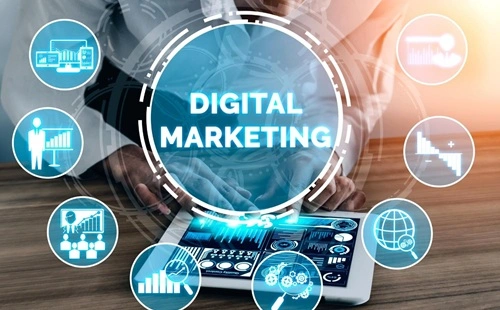Digital marketing has become the modern heartbeat of business growth, commanding over 70% of overall marketing budgets, with global digital ad spend expected to exceed $526 billion in 2024 and projected to surpass $1 trillion by 2030. In 2025, video dominates internet traffic, and short‑form mobile video drives 65% higher engagement. Artificial Intelligence (AI) is no longer optional—74% of marketers say AI improves campaign performance, and a rising majority plan to invest over $10 million annually in AI tools. As consumer expectations surge for personalization, interactivity, and authenticity, marketers must navigate strengths, weaknesses, opportunities, and risks professionally and strategically.

Strengths
1. Scalable Reach & Cost Efficiency: Digital channels—especially search, social media, and email—allow brands to reach billions at measurable cost. Email marketing continues to deliver an outstanding ROI of $36–$44 per $1 spent, while SEO drives over 68% of website traffic.
2. Mobile-First Dominance: With 78% of web traffic coming via mobile devices in 2025 and 80%+ of social ad spend tied to mobile usage, digital strategies must be mobile‑optimized to engage users effectively.
3. Rich Data & Precise Targeting: Data-driven tools and predictive analytics enable real-time targeting, behavioral segmentation, and personalization engines. Brands can now tailor messages at scale for conversion and loyalty.
4. Video as a Conversion Driver: Short-form video content reigns supreme—video makes up over 82–90% of internet traffic, while platforms like TikTok, Reels, and Shorts yield significantly higher engagement and purchase influence.
5. AI-Powered Efficiency & Creativity: AI and generative AI are transforming campaign development—from content generation to dynamic ad building. Over 70% of CMOs plan massive AI investment, and many small-to-mid brands are using GenAI to compete with large firms.
Weaknesses
1. Oversaturation & Creative Fatigue: Consumers are bombarded with marketing messages—information overload, ad fatigue, and banner blindness make standing out harder, especially for smaller brands.
2. Platform Dependency & Algorithm Risk: Reliance on algorithms and third-party platforms exposes businesses to sudden policy changes, reach reduction, or technical glitches. Loss of visibility can derail campaigns overnight.
3. Measurement & ROI Challenges: Although digital promises measurable outcomes, 40% of marketers struggle to prove ROI, and 58% say audience targeting is a barrier, while conversion rates remain modest for many.
4. Privacy Regulation & Trust Issues: Stricter regulations (GDPR, CCPA) and phasing out third‑party cookies mean marketers must pivot to first-party data and transparent consent strategies—failure risks consumer backlash.
5. Ad Fraud & Ad Blocking: Increasing use of ad blockers and fraudulent clicks/impressions reduce campaign effectiveness and waste budgets—compliance and verification protocols become essential.
Opportunities
1. Personalization at Scale via AI: GenAI enables real-time, hyper‑personalized content across emails, ads, web pages, and apps—boosting conversion rates by 42–80% when executed well .
2. Interactive & Immersive Experiences: AR/VR, voice search optimization, interactive video, and even nascent Web3 campaigns offer richer engagement paths. Matter like virtual try-ons and 0-click experiences are emerging frontiers.
3. Influencer Ecosystem & Social Commerce: With influencer marketing slated to be a $20–32 billion industry, strategic use of micro and nano‑influencers offers authentic reach and trust-building—particularly on social commerce channels .
4. Expanding Video & CTV Landscape: Connected TV (CTV) and live streaming video ads are growing rapidly. By 2026, video ad formats—including GenAI video—will constitute ~40% of digital ad inventory.
5. First‑Party Data & Privacy-Forward Models: Brands building robust consent-based CDPs, contextual targeting frameworks, and transparency-first marketing stand to gain consumer trust and data advantages in a cookieless future.
Threats
1. Privacy Laws & Regulatory Overhaul: New regulations—like the upcoming EU Digital Fairness Act—will impose rules on influencer marketing, data use, and personalization transparency, increasing compliance burdens.
2. Ethical & AI‑Related Legal Risk: Automated outreach—using cloned voices or behavioral targeting without consent—risks lawsuits under laws like the TCPA in the U.S., with damages up to $1,500 per violation.
3. Disinformation & Trust Erosion: Increasing volumes of AI-generated content, including deep fakes or biased messaging, pose risk to brand reputation and user trust unless transparency controls are in place.
4. Rapid Tech Obsolescence: Continuous emergence of new tools and platforms means marketing teams must constantly upskill—falling behind risks wasted spend and strategic irrelevance.
Future Outlook
AI‑First Marketing Becomes Standard: Brands will shift from using AI as an adjunct tool to embedding it in creative, targeting, optimization, and even campaign execution. GenAI‑driven video ads may account for 40% of all video content by 2026 .
Hyper‑personalization & Zero‑Party Data Models: Consumer expectations will demand hyper-personalized experiences. Brands with robust ethics-aligned first‑party data strategies, CDPs, and explainable AI tools will build sustainable trust.
Immersive & Interactive Content Explosion: AR/VR experiences, voice/visual search optimization, and interactive or shoppable video content will grow rapidly—especially in e‑commerce and premium retail sectors.
Social Commerce & Micro‑Influencer Monetization: Growth of social selling and influencer-led micro-campaigns will redefine conversion channels. Campaign automation, ROI tracking, and creator partnerships will scale.
Stronger Governance & Compliance: As regulators roll out frameworks like Digital Fairness Act, brands integrating consent, disclosure, and ethical AI governance will maintain reputational edge and avoid legal pitfalls.
Measurable Performance & Strategy Maturity: Solving the ROI puzzle—using transparent metrics, explainable targeting, and cross-channel attribution—will separate winners from laggards in digital marketing effectiveness.
Digital marketing in 2025 continues to flourish—driven by mobile-first behavior, video dominance, and explosive AI uptake. Yet the landscape demands more than tech—it requires strategy, ethics, creativity, and agility. Organizations that master personalization, manage privacy, and innovate through immersive, data‑driven experiences will lead the next phase in marketing evolution.